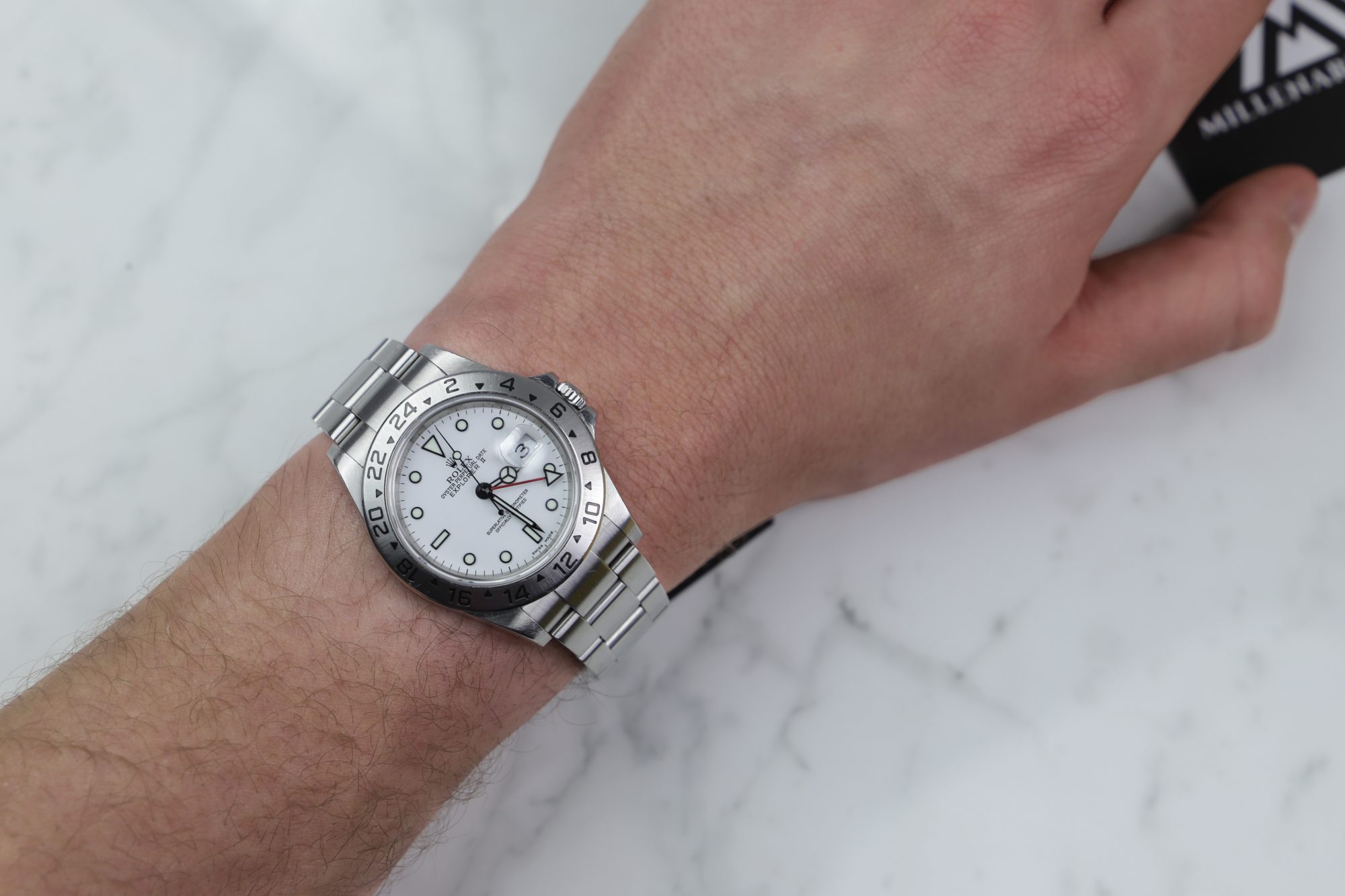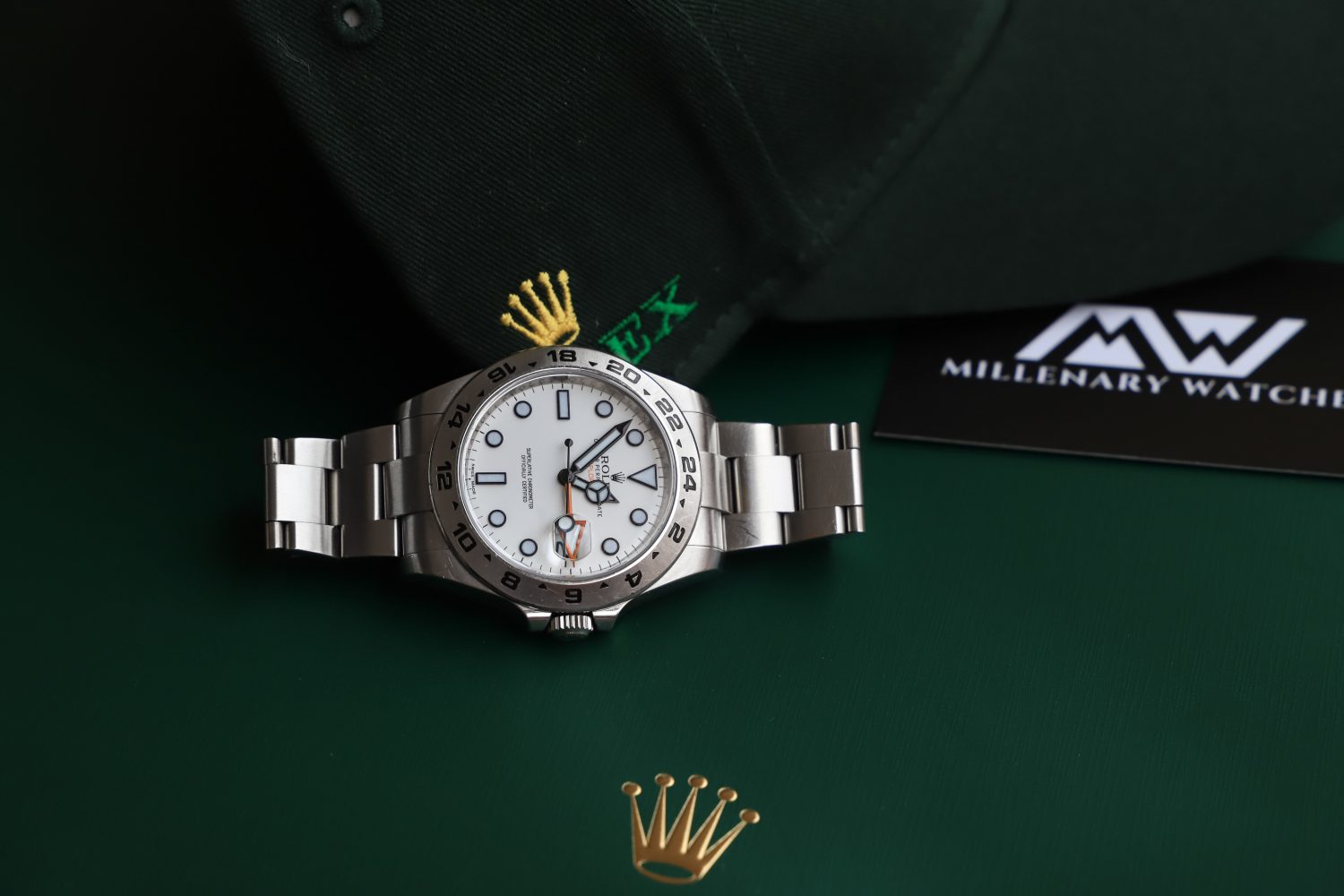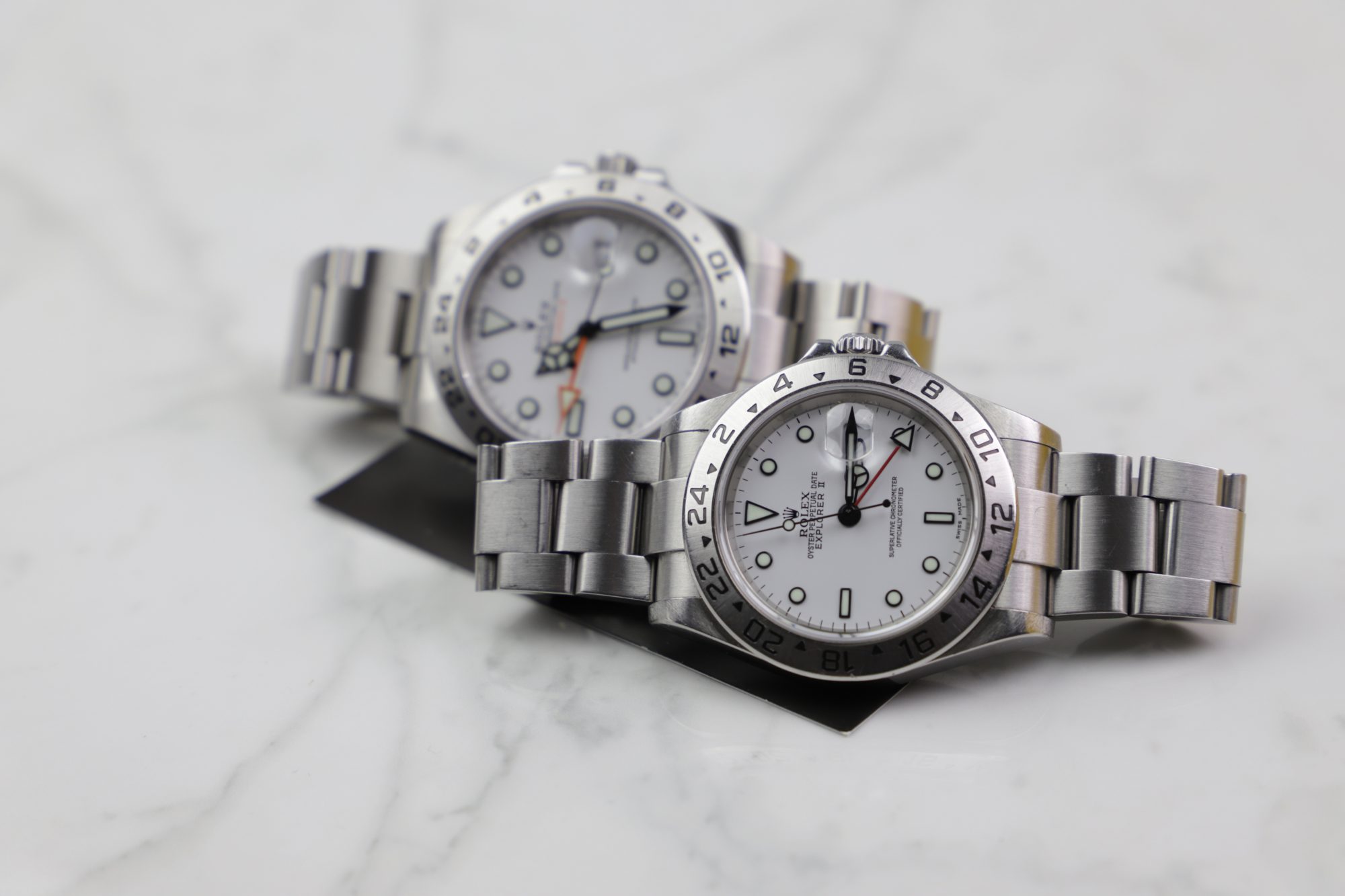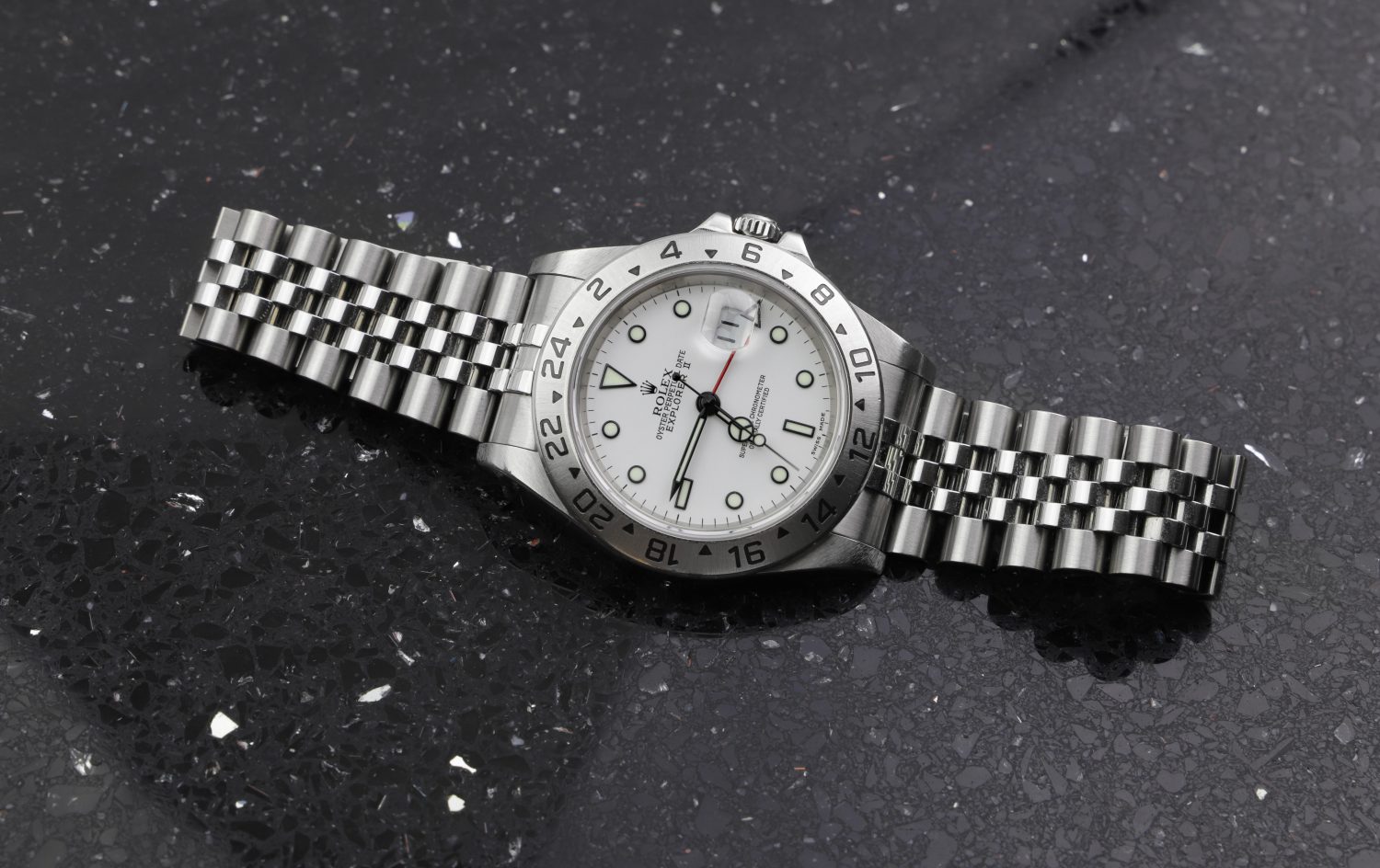
Rolex Explorer II 16570 – Complete Review & Guide
The Rolex Explorer II 16570 is part of Rolex’s lineup as the second generation – thereby the name Explorer II.
If you know Rolex, you know that it’s a very purposeful company, which focuses on making watches, functions, and design features that have a purpose, outside of the visual part.
Rolex has been making tool watches for a long time – from its Submariner made for professional divers, to the GMT-Master, developed specifically for Pan-Am pilots, and then there’s the Explorer.
The Rolex Explorer is a watch that doesn’t get very much recognition. It has always been a watch that falls in the shadow of Rolex’s other watches – in particular, the Submariner, yet despite this, the Explorer is a great watch, built to last. But why is that so? The Explorer has always been recognized as a great watch, that compromises on nothing, yet still, you could argue that the Explorer doesn’t get the recognition it deserves.
In this article, we’re looking at a watch that is often neglected in favor of other watches. But just because it is neglected doesn’t mean that the Explorer isn’t worth considering.
We’re looking closer at the Rolex Explorer II 16570.
What’s in the Explorer name?
First things first, there are two watches in Rolex’s Explorer lineup. There’s the Explorer, often referred to as the Explorer I, and then there’s the Explorer II.
For simplicity, I’ll sometimes use ”Explorer 16570”.
The name Explorer is quite revealing. It’s obvious that the Explorer is a rugged watch that is meant to be worn by explorers who spend time in harsh conditions – from climbing mountains to walking in Antarctica.
As such, the Explorer fills a gap in Rolex’s lineup of watches which are meant to be rugged watches that can take a beating and can manage any harsh environment that is thrown at it
Originally, the Explorer line was developed for a particular group of people, just like many of Rolex’s other tool watches, and this brings me to the next point.
History of the Rolex Explorer 16570
The Rolex Explorer II 16570, or any Explorer watch for that matter, is not most people’s first thought when they think of a Rolex. Most people think about the Submariner, or perhaps the Datejust, but the Explorer has always struggled with getting recognition.

On the flip side, the Rolex Explorer is a watch with a great history, and despite the fact that the Rolex Explorer II 16570 was released in 1988, let’s look at the history of the Explorer range as a whole, as it helps add context to how the 16570 came about.
In the 1950s, climbers and explorers were going on missions to climb mountains, The environments at these places are extremely harsh, to say the least. In Rolex’s words ”When climbers reach altitudes usually attained by cruising commercial jets and brave temperatures as low as -50°C (-58°F), confronting icy precipices and deadly winds, with 70 percent less oxygen than at sea level, they need the right gear.”
This is probably enough to explain why there was room for a new watch in Rolex’s lineup – the Explorer.
One may say that the story of the Rolex Explorer starts in 1953, on May 29th. It was on this day that Sir Edmund Hillary and Tenzing Norgay became the first people to ever reach Mount Everest’s 8,848-metre summit
As they climbed the mountain, they wore Rolex Oysters, just like many of the pioneering expeditions which climbed the Himalayan peaks from the 1930s did.
Following this event, In 1953, Rolex launched the Oyster Perpetual Explorer, which can be seen as the father of the Explorer range, but also the first Rolex Explorer I.
Despite the extremely harsh conditions, the Rolex Oyster proved itself extremely reliable and durable, and as such, it was time to introduce a watch that was made specifically for this.
With the help of the technical know-how from the Himalayan expeditions, Rolex created the most rugged Oyster watches in their lineup, developed for the most extreme environments.
The first Explorer had an all-steel bracelet and a new Twinlock winding crown which featured a double waterproofness system.

But as you know, the Rolex Explorer I is quite different in terms of design from the Explorer II. In fact, they look very different and even have different functions. It is, however, built with the same idea as the first Explorer, and built on the purpose that the Explorer always has had.
Now, the first Rolex Explorer II was released in 1971.
Established under the same model name, you can expect that there are some similarities with the Explorer I, but at the same time, there are quite a lot of differences. The Explorer II was an addition to the Explorer I, meant to complement it, not compete with it.
Most people’s first impression of the Explorer II 16570 is that it is a very sporty, robust, rugged, and durable piece. And it is still very much Rolex.

When it was launched, the 16570 became popular among people who had demanding professions, in often harsh environments, such as speleologists, volcanologists, and polar and jungle explorers. The key difference between the Explorer I and Explorer II is that it features an additional 24-hour indication that can also be used to keep track of a second time zone. The 24-hour indication is a feature that is extremely important for explorers, in particular, covers, which have extreme help from this feature. Unlike Rolex’s other GMT models, the bezel of the Explorer 16570 doesn’t rotate.
A defining feature of the Explorer II 16570 is that it is made to be extremely legible – even in poor conditions.
But the fact is that the Explorer 16570 is not the first Explorer II model in Rolex’s lineup. There have actually been several predecessors, and in true Rolex fashion, they’ve been discontinued and replaced by iterated models that have featured slight changes which have improved the watch’s performance and reliability.
The first Explorer II model had the reference 1655. This model was in production until 1984, and it was powered by the Cal. 1575GMT. It had a 39mm case, and it is very obvious that the latest generation Rolex Explorer II 226570 has taken inspiration from all of the previous Explorer II models, but more on the latest generation further on.
Maybe the most defining feature is its 24-hour bezel and the orange-tipped 24-hour hand which is now an iconic signature of the modern version.

Following the 1655 Explorer II, Rolex produced the Explorer II Ref. 16550 which was a transitional model from 1985 to 1988. This model is very similar to its predecessor, but it featured a new Cal. 3085 movement which enabled the GMT hand to be adjusted individually. It also had a 40mm case
The 16570 was produced for over 20 years before being discontinued, and this long production is evidence that Rolex was very satisfied with the watch, and that it had been iterated and refined to the point of perfection. But after 20 years, Rolex changed the movement to a Cal. 3186, and you can tell the watches that have this movement since they also have the ”ROLEXROLEXROLEX…” engraving around the rehaut. During this time, there were, however some transitional models, which featured the new movement but didn’t have the engraved reheat nor the drilled lugs on the case. The new movement Explorer 16570 was manufactured between 2007 and 2011 when we reach the end of an era and the 5-digit Explorer II reference number after several decades.
The caliber 3186 has a Parachrome Blue hairspring and is only slightly modified to the 3185, which has proven itself to be a highly accurate and reliable movement. As such, the Explorer 16570 is a watch that you could wear and use for many, many years, and it will keep the time perfectly, without servicing it.
In 2011, Rolex completely changed its Explorer II lineup when they introduced the 216570. This is the most recent generation Explorer, and although there are obvious similarities with the predecessor, the Explorer II 216570 is still very different.

First off, it uses a Rolex Cal. 3187, and the most notable difference is that the case went from 40 to 42mm, which makes a huge difference in how the watch wears. The most important reason for this though is that it improves legibility. Just like the 16570, the 216570 is available with two dial colors. Either black or ”Polar” white. Naturally, being tool watches, they’re made in sporty brushed 904L stainless steel, and equipped with an Oyster bracelet.

Now, let’s get back to the Explorer II 16570.
Rolex Explorer II 16570 specifications
The Explorer II 16570 features a sapphire crystal, which is now standard for all Rolex watches, but which also makes sense for explorers who put their watches in extreme conditions and aren’t using the watches lightly.
The later Explorer 16570s are equipped with the caliber 3186 which is a GMT movement.
Explorer 16570 case
With a diameter of 40mm, and with its relatively slim case size, the watch sits nicely on the wrist. Many people consider this case an ideal size, and would never be able to pull off the newer generation 42mm, but if you prefer larger watches, you may find the 16570 too small for your wrist.

In traditional Rolex fashion, the 16570 has polished sides contrasted by brushed elements, which, in this case, are the bezel and the lugs.
Because the watch isn’t thick from the movement on the backside, the Explorer 16570 is very slim on the wrist. Also, compared to the new Explorer II case, it isn’t a “Maxi Case”, which means the lugs are thinner, and the case is overall less bulky, which has a significant impact on how the watch wears, not just what it is on paper.
The bezel is a very distinct feature of this watch. It is brushed and features 24-hour markings, which have been ”engraved”, and then painted with black color. Naturally, over time, the color tends to loosen, and on older or more worn 16570s, the color could be almost completely gone.
A complaint people have about the bezel is that it doesn’t rotate, but one would assume that Rolex doesn’t make it rotatable in order to avoid having it accidentally rotate when wearing it.
Furthermore, with the bezel being in stainless steel, it tends to accumulate a lot of scratches over time.

Explorer 16570 bracelet
The Explorer II 16570 is equipped with a sporty Oyster bracelet. The complaint about this bracelet, however, is that it has hollow middle links, and while this makes the bracelet more lightweight, it compromises the quality and durability, as the bracelet tends to get more flimsy and stretch over time.
The bracelet is comfortable and sits great on the wrist, attached with a foldable lightweight clasp. The clasp is lightweight and the problem is that it feels quite cheap due to its lightweight and thin material. This is, of course, something that Rolex has realized and changed with its modern models, but the clasp on the 16570 does not give the best feeling of quality. The good thing about this clasp is that it sits nicely on the wrist, and allows the bracelet to sit unnoticed.
Seen below is a Rolex Explorer II 16570 with a 63600 Superjubilee bracelet. Note that this is not how the watch is delivered, but it is a possible modification you can make if you prefer the Jubilee.

Explorer 16570 crystal
As you’d expect, the Explorer 16570 is equipped with a sapphire crystal. It also features a glued-on cyclops magnifier for the date window. There will always be a debate about the symmetry of omitting the date or having the date and using it in everyday life., but the Explorer is very much a tool watch, and as such, you will probably use the date function and benefit from it.
The problem, however, is that the Cyclops has a poor anti-reflective coating, which means that it can be tricky to see the date from some angles because of glare.
Legibility of the Explorer II 16570
The Explorer II 16570 is made to be a watch that is easily legible. While it doesn’t feature maxi-dial, it has a dial design and hands that makes the dial easy to read. The black-dialed version has white applied markers, and the white-tailed version has white applied markers, but the white gold metal on the markers has been painted in black, just like the metal on the hands in order to allow for better legibility.
A minus of the Explorer 16570 is that it has a poor lume. It uses Superluminova for its indexes, but the Explorer 16570 is running a bit short on this material, which also makes the lime on the watch poor, and thus harder to read in the dark.

The red GMT hand on the watch gives a nice contrast and is the most legible element of the watch.
Conclusion
The Rolex Explorer II 16570 is considered to be among the most underestimated watches in Rolex’s lineup.
The model has never been immensely popular, and it also tends to be a watch that splits options.
It’s a watch that you either love or simply cannot see yourself wearing.

But the interest in the Rolex Explorer II 16570 has slowly increased over the years, and in recent times, their prices have also started going up. And while it has never been an insanely popular watch, it often tends to be the case that watches that are the least popular in their production years become the most sought-after as vintage pieces, but this is something that is up to the future to show.
The Explorer II 16570 is a very comfortable watch, and if you consider the new generation Explorer II too large, you’ll consider the 16570 perfect in size. It is also quite lightweight at 124 grams.
While the Explorer II is very much a sport watch, with its either white or black dial, it is a quite versatile watch, which not only can take a beating, but also looks great with a suit.





A classic Rolex tool watch in every sense. It is a real shame that the Explorer II doesn’t get the same attention as the other Rolex sports models. Nonetheless, it represents the best value for money luxury sports watches in the Rolex line-up and is probably more relevant to modern, active lifestyles of any man… or woman (bearing in mind the Explorer II was the first men’s Rolex to feature in an advertisement being worn by a woman -Fashion Designer Adrienne Vittadini in 1997). It is unfair that the E2’s lack of popularity is in part associated with the unromantic sport of spelunking, which just doesn’t have the same appeal as a diver’s watch (with the Submariner) or pilot’s watch (GMT Master II). But in reality, most of us, land lubbers who enjoy land based sports and the occasional bush trek, camping or hunting, the Explorer II is the perfect and most suitable tool for the pursuits of the everyday-man (or woman). Full stainless steel with less moving parts (i.e. bezel-less), with a handy second time-zone function, and 100m waterproof; this watch is the ideal watch for everyday use. You can swim with it, travel internationally with it, wearing playing cricket or wear it as elegantly into the boardroom or your wedding, this watch could be your one and only timepiece for life!
Ach. I saw one of these years ago. Noted the extra GMT hand and thought, this must be the GMT master! When I tried to buy one, they kept showing me watches like the poofy, and too flashy submariner. But I got there in the end.
Thank you for sharing, Simon!
It’s an amazing watch! Congratulations on a great piece!
Kind regards,
Millenary Watches
Look at the prices now in HK, etc rising like hell, spceiclaly on the 16570 T<25 dial. Just saying…
Yes, you’re absolutely right.
The 16570 has definitely increased in popularity, and especially tritium dial as a whole.
Kind regards,
Millenary Watches
I just purchased a 16570 circa 2000 Polar and absolutely Love it! I had to pay alot for a nice one, full set. They went under the radar but not anymore.
Rich
Excellent summary and all you need to know about this discreet, classy and timeless Rolex that flies under the radar screen. Indeed since I purchased mine one year ago I crossed nobody wearing it. Submariners and GMT Masters all over the place! But no Explorers II. That is what I was looking for. Those were the days when Rolex meant exclusivity: With the Ex II we have it back!
Thanks for sharing! And congratulations on an iconic and stunning timepiece!
Kind regards,
Millenary Watches